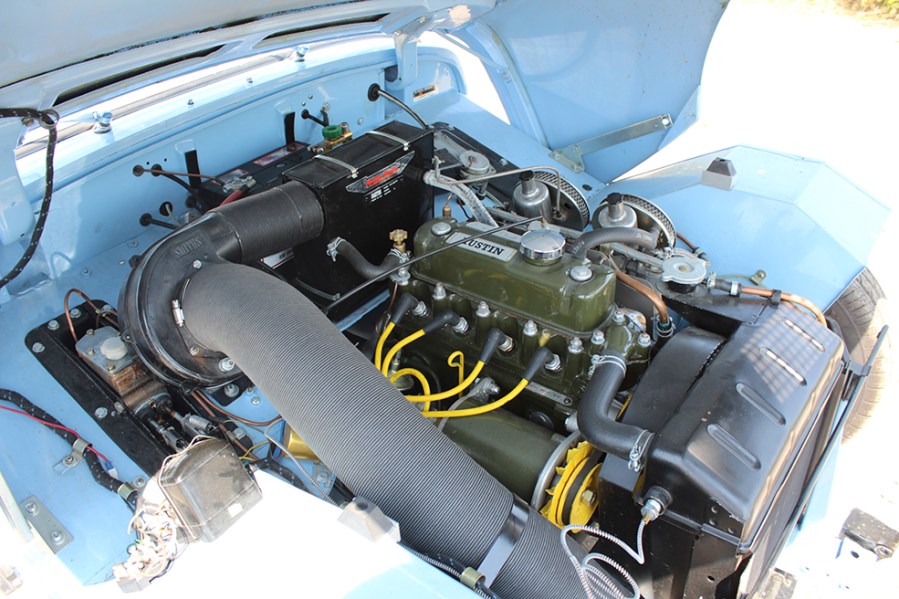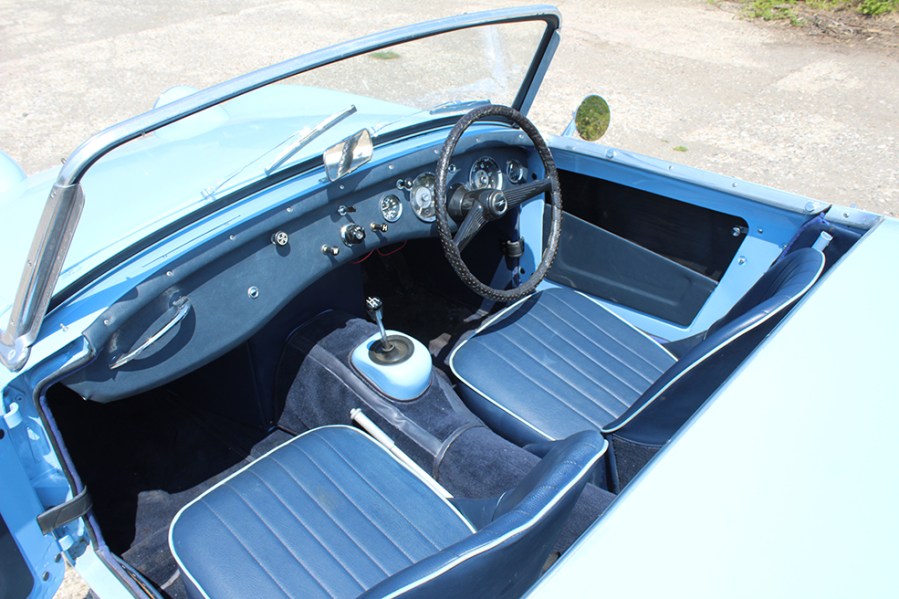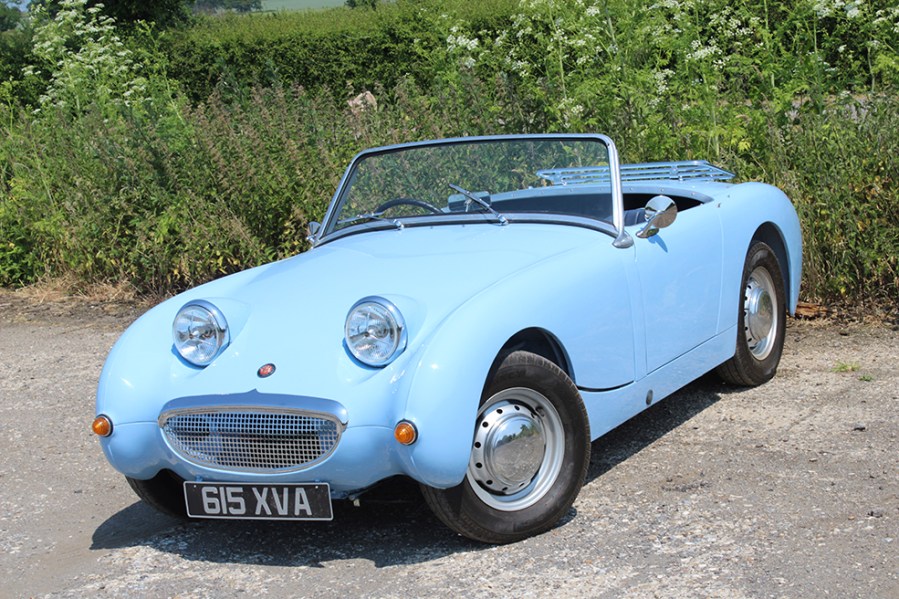We take the road in an early ‘Frogeye’ Sprite, a car that proves you don’t need headline-grabbing horsepower figures to have fun
Words and images: Jack Grover
Having brought big engines and high performance to the world of British sports cars with his ‘Big Healeys’, Donald Healey set his sights on the other end of the market in the late 1950s. His aim was to produce a modern replacement for both the traditional MG Midget of the 1930s and 1940s (a breed now going extinct since MG went upmarket with the MGA), the customised and sports-prepared versions of the Austin Seven (now also suffering from old age) and an over-the-counter alternative to the myriad of sporty kit cars on the market. Healey wanted his new car to be as small, as affordable and as easy to maintain and repair as possible, describing his idea as ‘the sort of thing a chap could keep in his bike shed.’
With his connections to Austin, it’s no surprise that Healey sourced much of his car’s mechanical parts from the Longbridge parts bin. The 948cc engine came from the Austin A35 (albeit with a second carburettor), as did the independent coil spring front suspension and the back axle. The steering rack was the highly regarded item from the Morris Minor.
Seeking a light but strong and stiff body, Healey pushed boundaries by giving the Sprite a monocoque body ‘tub’, making it one of the first unitary-build sports cars. Seeking strength and lightness meant that there was no boot lid, with luggage having to be squeezed under the rear deck behind the seats. Rear suspension was a shrunken version of the arrangement from the Le Mans-winning Jaguar D-type, with quarter-elliptic leaf springs.
The Sprite was launched in Monte Carlo in the aftermath of the 1958 Monaco Grand Prix, which immediately set the tone. The little car was a smash hit, proving to be exactly what a lot of people had been waiting for. Costing little more than a small saloon, the Sprite quickly proved to be a ‘giant killer’ with excellent cornering and roadholding abilities despite its modest power and limited outright performance.

The original ‘Frogeye’ Sprite is desirable on many levels. For some, the fact that it’s a small sports car (and, in this case, painted baby blue) would be enough. For others it’s the goggly headlamps and grinning grille that do it. Others will be more attracted to the Sprite’s famously sharp handling and rorty exhaust note. Still others will fancy it more for being a classic car in the true sense – the smallest and most basic of the small, basic British sports car breed and the scion of the ‘baby Healey’ line that was such a big seller through the 1960s.
Although there was a long line of small sports cars called Sprite after this original model, the original is distinct in several ways. Firstly, there are those unique looks – the legacy of Donald Healey’s personal input into the design process, even if it was Gerry Coker’s hand that put pen to drawing board. Thus, this is the simplest and lightest of the Sprites, without any extraneous equipment or details in the interior and not even a boot lid or external door handles, let alone winding windows or a fixed hood – although this one does have a heater.
That heater probably hasn’t been used much in the car’s life, since this Frogeye was exported to a ‘dry state’ in the USA, where it gently aged into a patinated but generally solid condition until it returned to British shores in 2015. It was then thoroughly restored during 2017 and 2018. That process saw the fitment of a 1098cc engine in place of the original 948cc unit, but it was otherwise left remarkably standard by Sprite terms, with effort clearly going into the quality of the restoration rather than dramatically changing the little car’s performance or character.
The remarkable thing is that having had all this work done to it the Sprite has seen very little time on the road, as is confirmed by a thick file of receipts covering its restoration and subsequent MoT history. This does at least mean that it remains in extremely presentable condition inside, outside, on top and underneath. Coming from a clement climate across the Pond, the Sprite’s steelwork (and that crucial monocoque body tub) was left relatively untouched, so it still has the proper steel bonnet/front section that hinges forward to reveal the engine. And while the curved panel gap where this meets the forward part of the sill – a good ‘tell tale’ for the structural strength and overall fit and finish on a Frogeye Sprite is a different breadth on each side, it is even along each side’s length and nowhere does the front section snag or scrape on wings or sills. That’s generally as good as the factory ever got them to fit, and it’s a big improvement on a lot of the glass fibre reproduction parts worn by many Sprites after a few decades in the British climate.

As well as the forget-me-not blue paintwork, which is a lovely even and glossy finish from the grille to the distinctive ‘Sprite’ badge on the rear, there are a couple of period-appropriate upgrades on this Sprite. At the front are Lucas P700 ‘tripod’ style headlamps and at the rear is a chromed luggage rack. The wheels are the original perforated steels discs and are in great condition. The interior is trimmed in dark blue fabric, and has the factory-spec minimalist instrumentation – aside from the classic Austin Healey silver-on-black dials, the oil pressure/water temperature gauge and the fuel gauge, there isn’t even an ammeter. Neither is there a Moto-Lita wheel, just the original two-spoke item with the ‘wings’ moulded into the spokes. Mechanical upgrades, aside from the slightly larger engine, are absent – we’re still on all-drum unassisted brakes and, while the later engine also brings the later gearbox with tougher synchromesh, there are still no synchro cones on first gear.
It doesn’t take long behind the wheel to conclude that this was the correct choice, because there’s something joyous about how basic and engaging a standard Frogeye Sprite is to drive, especially in this condition. The Sprite is absolutely the antidote to modern performance cars with more performance than can ever be realistically used on the road. The Sprite weighs slightly under 600kg, and so thrives on its 56 horsepower, delivered with a fizzy eagerness and a rorty note from the pea-shooter exhaust pipe. Combined with how low you sit and how little car is around you, the Sprite feels hugely quicker than it is, and this is emphasised by the short gearing, which keeps the revs up and the responses to prods of throttle briskly. The engine thrives at 2000-3500rpm, and keeping it in that band yields the best performance and the best noise. The gearbox feels a bit stiff in the changes (perhaps a symptom of having so few miles on it) but you quickly pick up the knack of slotting between gears.
The Sprite’s diminutive size turns a normal road into a personal racetrack – but one that can be enjoyed at only 30mph. You can see the front corners of the car thanks to the protruding wing tops, and the tarmac is framed perfectly by the headlamps bowls. The steering is very sharp, with very direct gearing, a smooth rack and absolutely no sense of lost motion between hands and tyres. The ride is firm and very short on travel, but the minimal weight stops it thudding or crashing. The car carrying such little weight also means that even the brakes aren’t anything like as much of a let-down as ‘drums on all four corners’ might prepare you for. They need a good, firm press to really start hauling the speed down but they have a lovely firm feel at the pedal and, once they bite, a progressive action.

Austin-Healey ‘Frogeye’ Sprite: our verdict
The Sprite really is the distilled essence of a sports car, and one that can be enjoyed to the full every time you venture out in it thanks to how playful it is at low speeds and even with low power. It is not the most practical or comfortable machine, but I don’t think any car can deliver the same returns for ‘smile per mile’, ‘smiles per kilo’ or ‘smiles per gallon’. And really, when allowing for the excellent condition of this example, it still rates pretty well in the ‘smiles per pound’ too. You could spent a lot more and not have a car that is in as good nick, wouldn’t be as fun to drive and wouldn’t turn as many heads.






